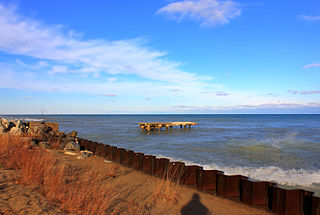
Lake County is a suburban county of Chicago situated in the northeastern corner of the U.S. state of Illinois along the shores of Lake Michigan. According to the 2010 census, it has a population of 703,462, making it the third-most populous county in Illinois after nearby Cook and DuPage Counties. Its county seat is Waukegan, the ninth-largest city in Illinois. Due to its location, immediately north of Cook County, Lake County is one of the collar counties of the Chicago metropolitan area.
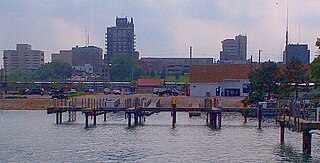
Waukegan is the largest city in and the county seat of Lake County, Illinois, United States. Situated approximately 35 miles (56 km) north of Downtown Chicago and 23 miles (37 km) northeast of O'Hare International Airport, it is a principal city within the Chicago metropolitan area. As of the 2010 census, the population of Waukegan was 89,078, making it the ninth most populous city in Illinois. Waukegan is a predominantly working-class community, with a sizeable middle-class population.

The Sycamore Historic District is a meandering area encompassing 99 acres (400,000 m2) of the land in and around the downtown of the DeKalb County, Illinois, county seat, Sycamore. The area includes historic buildings and a number of historical and Victorian homes. Some significant structures are among those located within the Historic District including the DeKalb County Courthouse and the Sycamore Public Library. The district has been listed on the National Register of Historic Places since May 2, 1978.

In the law regulating historic districts in the United States, a contributing property or contributing resource is any building, object, or structure which adds to the historical integrity or architectural qualities that make the historic district, listed locally or federally, significant. Government agencies, at the state, national, and local level in the United States, have differing definitions of what constitutes a contributing property but there are common characteristics. Local laws often regulate the changes that can be made to contributing structures within designated historic districts. The first local ordinances dealing with the alteration of buildings within historic districts was in Charleston, South Carolina in 1931.

The Bloomington freight station is a historic train station in downtown Bloomington, Indiana, United States. Constructed in the early twentieth century, it has endured closure and a series of modifications to survive to the present day, and it has been declared a historic site. Used only occasionally for many years, it is one of the most important buildings in a large historic district on the city's west side.

The Waukegan Building is a historic skyscraper in Waukegan, Illinois, United States. Located in what was the central business district, it was the city's first skyscraper when it opened in March 1925.

The Macomb Courthouse Square Historic District is a historic district located in downtown Macomb, Illinois. The district covers six full and four partial city blocks and includes 65 contributing buildings. The McDonough County Courthouse, an 1871 Second Empire building, is the centerpiece of the district. The courthouse is situated in the middle of a Harrisonburg-style courthouse square, which is flanked by two north-south streets and intersected by a single east-west street that splits around the courthouse; the layout is unusual in Illinois, though Stark County has a similar layout. The surrounding buildings are mainly commercial, though several are government buildings. Brick commercial blocks, often with Italianate or Queen Anne details, dominate the district's architectural landscape; the district's more modern buildings, which date to the first half of the twentieth century, mostly have Art Deco or Moderne styling.
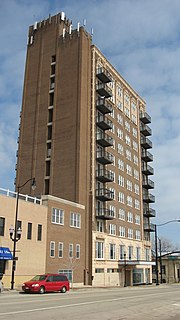
The Hotel Waukegan is a historic hotel building located at 102 Washington Street in Waukegan, Illinois. At an original height of 12 stories and 132 feet (40 m), the hotel is the tallest building in the city. Its architecture is primarily Renaissance Revival but incorporates a variety of styles; its decorative elements include elaborate terra cotta details on the upper and lower stories and quoin-like terra cotta at its corners. The hotel opened in 1927 during a population and economic boom in Waukegan; it is the better-preserved of the city's two surviving hotels from this period. While the hotel struggled financially in its early years, it stabilized in the 1930s; from then on, it served as both a modern hotel for travelers and laborers and a meeting place for community events.

The Ridge Historic District is a residential historic district in the Beverly and Morgan Park neighborhoods of Chicago, Illinois. As its name suggests, the district is centered on a ridge, making it one of the few areas of high ground in the generally flat city. Development in the district began in the late nineteenth century, as the Rock Island Line brought access to downtown jobs and several private schools opened in the area, and continued through the early twentieth century. Real estate atop the ridge was particularly sought after for its views and attracted wealthy residents, while the area's working-class population typically lived near the railroad stations. The district's houses exhibit a variety of popular architectural styles from its period of growth; its Prairie School architecture is especially noteworthy, including twelve designs by Walter Burley Griffin and multiple Frank Lloyd Wright works.

The Buena Park Historic District is a residential historic district in the Uptown neighborhood of Chicago, Illinois. First developed in the 1890s, the district was originally planned to be an upper-class suburban neighborhood of Chicago with spacious homes. Development in the early twentieth century made the neighborhood denser, and while it was still a wealthy neighborhood by 1930, it featured many apartment buildings as well. The district's houses reflect Chicago's architectural development at the turn of the century; while its nineteenth-century homes have Queen Anne and Romanesque Revival designs, its twentieth-century houses exhibit newly popular styles such as the Prairie School and Classical Revival. The district's apartment buildings were designed in part to match the character of its houses, as doing so portrayed a sense of luxury and domesticity to its affluent residents; as a result, they largely used the same styles as the twentieth-century homes and often included courtyards to replace lawns.
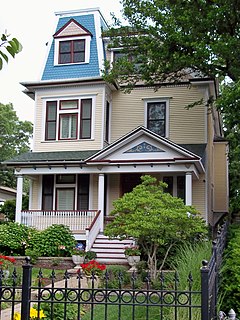
The Sheridan Park Historic District is a residential historic district in the Uptown neighborhood of Chicago, Illinois. Developed between 1891 and 1929, the district is a collection of single-family homes, small apartment buildings, and a handful of larger apartment hotels. The homes were built early in the district's development, with nearly all of them completed by 1910; at the time, the district was planned as a spacious suburb and categorized with North Shore communities. The apartments were all built in the twentieth century as the dense city core of Chicago expanded into the district. The district includes a large collection of six-flat apartments in particular; small apartments such as these, which were only three stories tall, fit neatly among the single-family houses of the original neighborhood.

The Rogers Park Manor Bungalow Historic District is a residential historic district in the West Ridge neighborhood of Chicago, Illinois. The district includes 329 buildings, 247 of which are Chicago bungalows built in the 1920s. As homeownership became more accessible to working-class Chicagoans in the early twentieth century, bungalows became an affordable and popular style due to their easily replicable design, and tens of thousands of the houses were built throughout Chicago. The Rogers Park Manor area was typical of new bungalow neighborhoods, as it was an underdeveloped outlying neighborhood near the city's northern edge. The bungalows in Rogers Park Manor were built by several different developers and architects, which led to variation in the size and shape of the homes despite their similar designs.

The Rochelle Downtown Historic District is a national historic district in downtown Rochelle, Illinois. The district includes 56 buildings, most of which are commercial buildings. Commercial development in Rochelle began in the 1850s, but several fires burned down all of the earliest buildings; the oldest surviving buildings in the district were built in 1871. Development in the district continued through the mid-twentieth century. While a variety of architectural styles can be found in the district, Italianate and vernacular commercial designs are the most common. Noteworthy non-commercial buildings in the district include the City and Town Hall, U.S. Post Office, Masonic Temple, and Chicago & North Western Railway depot.

The Karcher Hotel is a historic hotel building at 405 Washington Street in Waukegan, Illinois. Opened in 1928, the hotel was built during an economic boom in Waukegan; its location near Waukegan's train station and downtown businesses was chosen to attract traveling businesspeople. In addition to renting rooms, the hotel housed commercial and office spaces on its first two floors. Architect B.K. Gibson of Chicago designed the hotel in the Classical Revival style; his design used the tripartite form common to Classical Revival skyscrapers, which included a two-story terra cotta base, a brick shaft, and an upper floor demarcated by terra cotta panels. Other classically inspired elements in the building include its terra cotta frieze, cornice, and parapet along with egg-and-dart and dentil detailing. While the hotel prospered during the Great Depression, it began to suffer economically in the 1960s and would ultimately close in 1981.
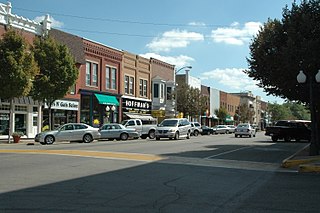
The Princeton South Main Street-Courthouse Square Historic District is a national historic district in Princeton, Illinois. Centered on South Main Street and the Bureau County Courthouse, the district is the older of the two downtown areas in Princeton, with the other being on North Main Street. Development in the area began with the settlement of Princeton in the 1830s and continued through the mid-twentieth century. The courthouse square was established when the county's first courthouse opened in 1845; the current Art Moderne courthouse was built there in 1937. South Main Street was considered the more upscale of Princeton's two downtowns, as it lacked the functional and agricultural businesses associated with the city's railroad station. The district's buildings reflect the popular architectural styles of the nineteenth and twentieth centuries; Italianate and Arts and Crafts designs are especially common, though Green Revival, Queen Anne, Neoclassical, Prairie School, and Moderne buildings are also present.
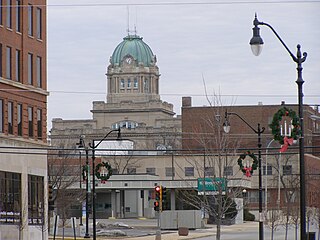
The Kankakee Downtown Historic District is a national historic district in downtown Kankakee, Illinois. The district includes 73 buildings which form the commercial and governmental center of the city, most of which are grouped along Court Street and Schuyler Avenue. While development in the district began in the 1850s, the oldest surviving building in the district is from 1864; the newest contributing buildings are from the mid-twentieth century. Kankakee's Courthouse Square and the 1908 Kankakee County Courthouse are part of the district; other government buildings in the district include Kankakee's post office, police and fire station, and armory. Most of the district's other buildings are one- to three-story brick or stone commercial buildings. Many popular architectural styles of the nineteenth and twentieth centuries are represented in the district; the Italianate, Neoclassical, and Art Deco styles are among the most common.

The Ouilmette North Historic District is a residential historic district in northeastern Wilmette, Illinois. The district includes 911 contributing buildings; all are houses except for two churches, Trinity United Methodist Church and the Community Church of Wilmette. The southern half of the district was originally part of the Ouilmette Reservation, an Indian reservation which was sold to developers and became the original village of Wilmette in 1872. Development in the district began after the village's incorporation and continued through World War II, with most new construction happening in the early twentieth century. The district includes examples of Queen Anne architecture from the late nineteenth century, Prairie School architecture from the first two decades of the twentieth century, and revival style architecture from the 1920s. Its Prairie School architecture is especially notable as it contains works by William Eugene Drummond and John S. Van Bergen, two early Prairie School architects who practiced with Frank Lloyd Wright.

The Downtown Peoria Historic District is a commercial historic district encompassing seventeen city blocks in downtown Peoria, Illinois. The district's buildings reflect Peoria's development as an industrial center and major Illinois city. While Peoria was platted in the 1820s, the oldest buildings in the district date from 1867, shortly before Peoria's economic boom of the 1870s. In the late nineteenth century, Peoria's whiskey industry was among the largest in the world, and many downtown civic improvements and public buildings were funded by whiskey profits. By the turn of the twentieth century, another economic boom brought a large retail district to downtown Peoria; many of the department stores from this period still stand in the district. An urban renewal project in the mid-twentieth century brought several Modernist skyscrapers to downtown Peoria as well, including the Caterpillar administration building, the DeKroff Metz and Company Building, and the First Federal Savings Tower.

The Champaign Downtown Commercial District is a commercial historic district encompassing 19.4 acres (7.9 ha) in downtown Champaign, Illinois. The district includes some of the oldest parts of the city's downtown, and its buildings represent the city's development in the late nineteenth and early twentieth centuries. Champaign was founded in the 1850s when the Illinois Central Railroad added a station in a rural area west of neighboring Urbana and the town formed around it; the oldest buildings in the district date from the following decade. Several buildings connected to the Illinois Central are included in the district. The opening of the University of Illinois at Urbana–Champaign in 1867 furthered Champaign's growth, and development in the downtown commercial district continued steadily through 1940. The district's commercial buildings exhibit a variety of building types and architectural styles, including Italianate, Art Deco, and various revival styles. Champaign's City Building and other local government buildings are also part of the district.

The Downtown Rock Island Historic District is a national historic district encompassing 82.3 acres (33.3 ha) in downtown Rock Island, Illinois. The oldest buildings in the district are from the 1860s, two decades after Rock Island's founding, and buildings from then until 1969 can be found in the district, making it reflective of the city's development over time. The majority of the buildings in the district are commercial buildings, as downtown Rock Island has historically been the city's commercial center; these include several building types, mainly one-part and two-part commercial blocks, designed in a wide variety of the architectural styles popular in the late nineteenth and early to mid twentieth centuries. The district was also historically the center of Rock Island's social life, and many theaters and clubhouses for social organizations can be found in the district. Several of Rock Island's major government buildings, including the city hall and old county courthouse, are also part of the district.






















